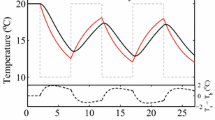Abstract
The metabolic rate of free-ranging animals is difficult to measure, but of great importance in understanding the interactions of a species with its environment. Heart rate can, if correctly validated and calibrated, give an estimate of metabolic rate, with both a fine time resolution and over long periods. The telemetry of heart rate is well documented, but is not appropriate over long ranges (possibly several thousands of kilometres) or for diving species. An implantable data logger has therefore been developed for the long term recording of heart rate and body temperature. The logger is built using hybrid and ASIC construction techniques, weighs 20 g and measures 55×24×6 mm. The device is programmable, and its solid-state memory holds over 70 days of data if, for example, heart rate is counted and stored every minute. Current consumption is 155 μA while logging, 50 μA during a programmable initial delay period, and less than 1 μA when the logger closes down after filling its memory. These loggers have been deployed for two field seasons in gentoo penguins, black-browed albatross and fur seals.
Similar content being viewed by others
References
Butler, P. J., Woakes, A. J., Boyd, I. L., andKanatous, S. (1992): ‘Relationship between heart rate and oxygen consumption during steady state swimming in California sea lions,’J. Exp. Biol.,170, pp. 35–42
Butler, P. J., andWoakes, A. J. (1989): ‘Telemetry’in Bridges, C. R., andButler, P. J., (Eds.) ‘Techniques in comparative respiratory physiology’ (Cambridge University Press, Cambridge) pp. 139–170
Hill, R. D., Schneider, R. C., Liggins, G. C., Hochachka, P. W., Schuette, A. H., andZapol, W. M. (1983): ‘Microprocessor controlled recording of bradycardia during free diving of the Antarctic Weddell seal,’Federal Proc.,42, p. 470
Holter, N. J. (1961): ‘New method for heart studies,’Science,134, pp. 1214–1220
Kooyman, G. L., Billups, J. O., andFarwell, W. D. (1983): ‘Two recently developed recorders for monitoring diving activity of marine birds and mammals’in MacDonald, A. G., andPriede, I. G., (Eds.): ‘Experimental biology at sea’ (Academic Press, London & New York), pp. 197–214
McConnell, B. J., Chambers, C., andFedak, M. A. (1992): ‘Foraging ecology of southern elephant seals in relation to the bathymetry and productivity of the southern oceans,’Ant. Sci.,4(4), pp. 393–398
Nolet, B. A., Butler, P. J., Masman, D., andWoakes, A. J. (1992): ‘Estimation of daily energy expenditure from heart rate and doubly labelled water in exercising geese,’Physiol. Zool.,65(6), pp. 1188–1216
Wilson, R. P., Burger, A. E., Wilson, B. L. H., Wilson, M.-P., andNöldeke, C. (1989): ‘A disposable depth gauge for marine mammals,’Mar. Biol.,103, pp. 275–383
Wilson, R. P., Cooper, J., andPlötz, J. (1992): ‘Can we determine when marine endotherms feed? A case study with seabirds,’J. Exp. Biol.,167, pp. 267–275
Woakes, A. J. (1988): ‘Metabolism in diving birds: studies in the laboratory and field,’Can. J. Zool.,66, pp. 138–141
Author information
Authors and Affiliations
Rights and permissions
About this article
Cite this article
Woakes, A.J., Butler, P.J. & Bevan, R.M. Implantable data logging system for heart rate and body temperature: its application to the estimation of field metabolic rates in Antarctic predators. Med. Biol. Eng. Comput. 33, 145–151 (1995). https://doi.org/10.1007/BF02523032
Received:
Accepted:
Issue Date:
DOI: https://doi.org/10.1007/BF02523032




